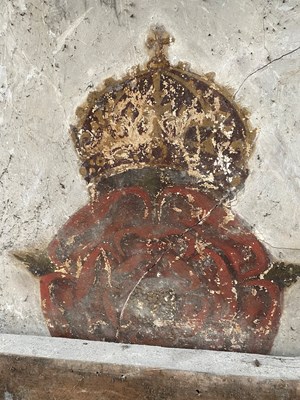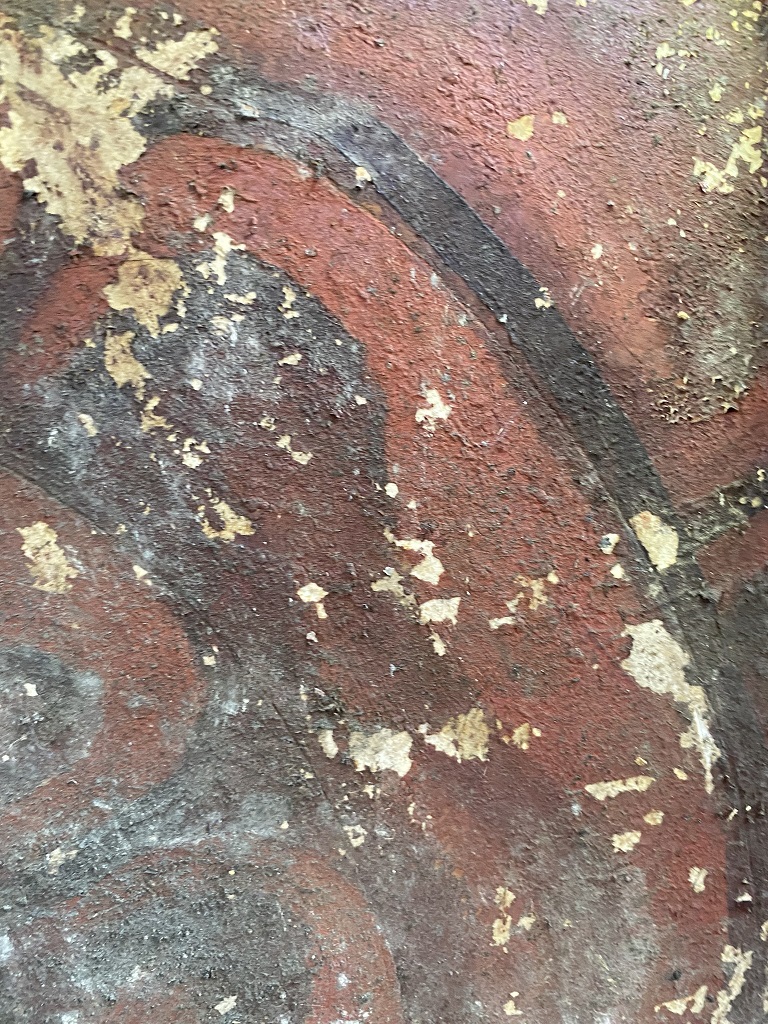
Rare medieval wall paintings have been uncovered in a loft space during restoration of fifteenth-century First Court.
Three crowned motifs on a plain white background, likely to date from the early sixteenth century, depict a red Lancastrian rose in the centre, with a portcullis to the left, and a probable fleur-de-lis on the right.
The wall paintings in the loft space. Photo: Tobit Curteis Associates LLP
First established as God's House in 1437, and moved to the present site in 1448, the College was re-founded as Christ’s College in 1505 by Henry VII’s mother, Lady Margaret Beaufort. The portcullis was the badge of the Beaufort family.
The crowned portcullis partially obscured by a joist. Photo: Tobit Curteis Associates LLP
University of Cambridge art historian Dr Christina Faraday, who specialises in Tudor visual and material culture, said:
“This is a really exciting and unusual discovery, revealing the ways that the College celebrated and advertised its royal patron during the early years of the sixteenth century, following its re-founding.
A powerful and pious woman, with a keen interest in scholarship, Lady Margaret left her indelible mark on the College, and the wall paintings are an early example of her family’s savvy use of visual ‘branding’ even beyond the royal court.
Henry VII had a very weak claim to the throne, but became adept at using visual symbols like this to promote his kingship. The motifs continue to be tied up with the College’s identity to this day, but as an early example of Tudor ‘marketing’, the wall paintings demonstrate the long history of something we think of as a modern phenomenon.”
Dr Faraday says that the red Lancastrian rose is popularly thought to have been the badge of one of the two warring houses during the Wars of the Roses, but was most probably invented by Henry VII after his victory, to mirror the Yorkist emblem of the white rose.
The red rose’s more famous counterpart is the combined Tudor rose, representing the union of the House of Lancaster and the House of York after the marriage of Henry VII and Elizabeth of York in 1486, and primarily used by their children.
The fleur-de-lis symbol has represented English kings since the time of Edward III when they also claimed to be kings of France.
“Such survivals are extremely unusual,” said Dr Faraday. “Wall paintings were a relatively cheap and disposable form of decoration, and so were rarely deliberately preserved. Now we can appreciate them for their historical value and what they reveal about Tudor art beyond the more traditional portraits.”
The six-metre-wide design – partially obscured by a wooden joist – is located in the roof space of what probably formed the north-west wall of the original Library. It is painted on to a fine plaster layer with evidence of limewash applied around the designs.
Some of the techniques used to create the heraldic designs are still visible today, for example, there is evidence of circles incised into the plaster using a compass to create the Lancastrian rose.
 Detail of setting out techniques: incisions in the plaster. Photo: Tobit Curteis Associates LLP
Detail of setting out techniques: incisions in the plaster. Photo: Tobit Curteis Associates LLP
After the discovery was made, the College delved into its archives and found that the last known recorded sight of the wall paintings was in around 1738.
The covered location in the roof space has enabled the survival of the wall paintings in such good condition, but means they will not be on general view. The College has obtained specialist advice about how to protect and conserve the paintings during the ongoing restoration and in the future.
Simon, Lord McDonald of Salford, Master said:
“It was a surprise when these wall paintings, which have been hidden for almost 300 years, were revealed. I am privileged to be one of the few people to see them up close.
At Christ’s we value all evidence of our Founder; this most fragile evidence has survived by concealment. After basic restoration, we will store the paintings away once again, a time-capsule which might be uncovered in another 300 years.”
Main Image :The red Lancastrian rose with the imperial crown above. Photo: Tobit Curteis Associates LLP

ArtDependence Magazine is an international magazine covering all spheres of contemporary art, as well as modern and classical art.
ArtDependence features the latest art news, highlighting interviews with today’s most influential artists, galleries, curators, collectors, fair directors and individuals at the axis of the arts.
The magazine also covers series of articles and reviews on critical art events, new publications and other foremost happenings in the art world.
If you would like to submit events or editorial content to ArtDependence Magazine, please feel free to reach the magazine via the contact page.